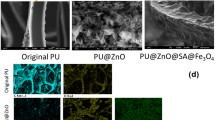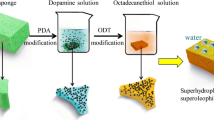Abstract
Development of porous materials with anti-fouling and remote controllability is highly desired for oil-water separation application yet still challenging. Herein, to address this challenge, a sponge with unusual superhydrophilicity/superoleophobicity and magnetic property was fabricated through a dip-coating process. To exploit its superhydrophilic/superoleophobic property, the obtained sponge was used as a reusable water sorbent scaffold to collect water from bulk oils without absorbing any oil. Owing to its magnetic property, the sponge was manipulated remotely by a magnet without touching it directly during the whole water collection process, which could potentially lower the cost of the water collection process. Apart from acting as a water-absorbing material, the sponge can also be used as affiliation material to separate water from oil-water mixture and oil in water emulsion selectively, when fixed into a cone funnel. This research provides a key addition to the field of oil-water separation materials.
Similar content being viewed by others
References
Schrope M. Oil spill: Deep wounds. Nature, 2011, 472(7342): 152–154
Wang B, Liang W, Guo Z, et al. Biomimetic super-lyophobic and super-lyophilic materials applied for oil/water separation: a new strategy beyond nature. Chemical Society Reviews, 2015, 44(1): 336–361
Ge J, Zhao H Y, Zhu H W, et al. Advanced sorbents for oil-spill cleanup: recent advances and future perspectives. Advanced Materials, 2016, 28(47): 10459–10490
Nordvik A B, Simmons J L, Bitting K R, et al. Oil and water separation in marine oil spill clean-up operations. Spill Science & Technology Bulletin, 1996, 3(3): 107–122
Chu Z, Feng Y, Seeger S. Oil/water separation with selective superantiwetting/superwetting surface materials. Angewandte Chemie International Edition, 2015, 54(8): 2328–2338
Peng Y B, Guo Z G. Recent advances in biomimetic thin membranes applied in emulsified oil/water separation. Journal of Materials Chemistry A: Materials for Energy and Sustainability, 2016, 4(41): 15749–15770
Ma Q, Cheng H, Fane A G, et al. Recent development of advanced materials with special wettability for selective oil/water separation. Small, 2016, 12(16): 2186–2202
Ge B, Zhang Z, Zhu X, et al. A graphene coated cotton for oil/water separation. Composites Science and Technology, 2014, 102: 100–105
Zhu X, Zhang Z, Ge B, et al. A versatile approach to produce superhydrophobic materials used for oil-water separation. Journal of Colloid and Interface Science, 2014, 432: 105–108
Li J, Kang R, Zhang Y, et al. Facile fabrication of superhydrophobic meshes with different water adhesion and their influence on oil/water separation. RSC Advances, 2016, 6(93): 90824–90830
Ren G, Song Y, Li X, et al. A superhydrophobic copper mesh as an advanced platform for oil-water separation. Applied Surface Science, 2018, 428: 520–525
Guan H, Cheng Z, Wang X. Highly compressible wood sponges with a spring-like lamellar structure as effective and reusable oil absorbents. ACS Nano, 2018, 12(10): 10365–10373
Yu T L, Lu S X, Xu W. G. A reliable filter for oil-water separation: Bismuth coated superhydrophobic/superoleophilic iron mesh. Journal of Alloys and Compounds, 2018, 769: 576–587
Xue Z, Wang S, Lin L, et al. A novel superhydrophilic and underwater superoleophobic hydrogel-coated mesh for oil/water separation. Advanced Materials, 2011, 23(37): 4270–4273
Kota A K, Kwon G, Choi W, et al. Hygro-responsive membranes for effective oil-water separation. Nature Communications, 2012, 3(1): 1025
He K, Duan H, Chen G Y, et al. Cleaning of oil fouling with water enabled by zwitterionic polyelectrolyte coatings: overcoming the imperative challenge of oil-water separation membranes. ACS Nano, 2015, 9(9): 9188–9198
Yang R, Moni P, Gleason K K. Ultrathin zwitter ionic coatings for roughness-independent underwater superoleophobicity and gravity-driven oil-water separation. Advanced Materials Interfaces, 2015, 2(2): 1400489
Gao S, Sun J, Liu P, et al. A robust polyionized hydrogel with an unprecedented underwater anti-crude-oil-adhesion property. Advanced Materials, 2016, 28(26): 5307–5314
Zhang S, Jiang G, Gao S, et al. Cupric phosphate nanosheetswrapped inorganic membranes with superhydrophilic and outstanding anticrude oil-fouling property for oil/water separation. ACS Nano, 2018, 12(1): 795–803
Yang H C, Xie Y, Chan H, et al. Crude-oil-repellent membranes by atomic layer deposition: oxide interface engineering. ACS Nano, 2018, 12(8): 8678–8685
Wenzel R N. Resistance of solid surfaces to wetting by water. Industrial & Engineering Chemistry, 1936, 28(8): 988–994
Jung Y C, Bhushan B. Wetting behavior of water and oil droplets in three-phase interfaces for hydrophobicity/philicity and oleophobicity/philicity. Langmuir, 2009, 25(24): 14165–14173
Yang J, Zhang Z, Xu X, et al. Superhydrophilic-superoleophobic coatings. Journal of Materials Chemistry, 2012, 22(7): 2834–2837
Xu Z, Zhao Y, Wang H, et al. A superamphiphobic coating with an ammonia-triggered transition to superhydrophilic and superoleophobic for oil-water separation. Angewandte Chemie International Edition, 2015, 54(15): 4527–4530
Zhu Q, Tao F, Pan Q. Fast and selective removal of oils from water surface via highly hydrophobic core-shell Fe2O3@C nanoparticles under magnetic field. ACS Applied Materials & Interfaces, 2010, 2(11): 3141–3146
Calcagnile P, Fragouli D, Bayer I S, et al. Magnetically driven floating foams for the removal of oil contaminants from water. ACS Nano, 2012, 6(6): 5413–5419
Chen N, Pan Q. Versatile fabrication of ultralight magnetic foams and application for oil-water separation. ACS Nano, 2013, 7(8): 6875–6883
Fowkes F M. Attractive force at interface. Industrial & Engineering Chemistry, 1964, 56(12): 40–52
Owens D, Wendt R. Estimation of the surface free energy of polymers. Journal of Applied Polymer Science, 1969, 13(8): 1741–1747
Wang Y, Di J, Wang L, et al. Infused-liquid-switchable porous nanofibrous membranes for multiphase liquid separation. Nature Communications, 2017, 8(1): 575
Tian X, Verho T, Ras R H A. Moving superhydrophobic surfaces toward real-world applications. Science, 2016, 352(6282): 142–143
Acknowledgements
This work was supported by the National Natural Science Foundation of China (Grant No. 11704321) and the Natural Science Foundation of Shandong Province (ZR2016JL020 and ZR2019MEM044), and the Yantai Science and Technology Plan Projects (2019XDHZ087).
Author information
Authors and Affiliations
Corresponding authors
Ethics declarations
Disclosure of potential conflicts of interests The authors declare no potential conflicts of interests.
Electronic supplementary material
Supplementary material, approximately 15.8 MB.
Rights and permissions
About this article
Cite this article
Lu, J., Zhu, X., Miao, X. et al. An unusual superhydrophilic/superoleophobic sponge for oil-water separation. Front. Mater. Sci. 14, 341–350 (2020). https://doi.org/10.1007/s11706-020-0516-6
Received:
Accepted:
Published:
Issue Date:
DOI: https://doi.org/10.1007/s11706-020-0516-6




